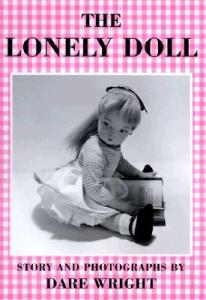Every doll is lonely...

It's really weird how tastes change. This book was published in 1957, and I think part of the problem is that it's illustrated with photographs and that they're all black and white. They are photographs of toys, so the toys can't actually show any emotion. But I'm sure at the time that this was written it made a lot of sense. It was probably just a run-of-the-mill book at the time, but now it comes across as kind of creepy, as dark and twisted. It's just the aesthetic of it that's creepy. Kind of a horror aesthetic with the black and white. But obviously in the 1950s, if you had photographs, that's what you had. They didn't have that many color photographs, and it would have been prohibitively expensive to publish a book of color photographs for children. There's no people in it (although there are, oddly enough, pigeons), just a doll and other toys. The doll's name is Edith, and she lives alone in a nice house. She's very lonely, so she prays for some friends. One morning she looks in the garden, and there are two teddy bears there: Mr. Bear and Little Bear, and they've come to be her friends. She says, you must have come because I wished so hard! (Oddly, they don't respond to that.)
It's almost like the author wrote this story for a daughter with a doll who then got some teddy bears to make up a story so she could incorporate the bears into the narrative she already had for the doll. If you look at it that way, it makes perfect sense. The doll and the bears play, Mr. Bear acting like a parent and making them do lessons and taking them places. They go to the park. They go to the beach. They go fishing. Mr. Bear has to scold them if they get too dirty, or they climb too high, or if they go too far away alone. One day, Mr. Bear leaves them at home by themselves, so Edith and Little Bear are bored and decide to explore the house. It explicitly says that the things in the house are not theirs, which is this weird kind of fourth-wall-breaking moment, where you wonder where the human who presumably owns the toys and bathroom sundries actually is. But Edith does her hair and dresses up in the clothes they find. They write on the mirror with lipstick. They spill the water from a vase. They make a huge mess. Basically, they get into all kinds of stuff. Mr. Bear comes home in the middle of this, gets understandably mad at them, spanks them (because that's what you did in the 50s-- presumably the author wouldn't have had that happen if this were written nowadays), and the doll is very sad because Mr. Bear is so angry. She's afraid that he's so mad that he's going to take Little Bear and go, and that she'll be all alone again. This is clearly the first time that he's gotten that upset-- he doesn't seem to have spanked them before. So they clean everything up and apologize, and she says, "I love you. Will you promise to stay with me forever?" And they promise, and the book says that they do.
I like the theory of the story being a justification for adding new toys to an established narrative. But beyond that, the doll and the little bear are children and they get into trouble, and the older bear is like a father to them, and he gets mad at them because they do something that they know they're not supposed to do. That's not an unreasonable fear for a child to have: if your parent gets extremely angry at you, angrier than they've ever been before, will they abandon you? And this book could reassure children of that. The message of this book is that no matter how mad your parents get, they still love you. Maybe it doesn't do a very good job of conveying that message, but that's clearly what the author is trying to get across with this book. I can't get any other message out of it unless I start going down the creepy route, which is like, "She was all alone and then suddenly two bears appeared from nowhere and then they live with her forever and ever... ha ha ha..." You can read it as a creepy book if you like, but you can also just read it as kind of a product of the times with a little bit of dated stuff like spanking and black-and-white pictures. But the storyline itself has a relevant message for today's kids. Sometimes parents get mad and sometimes they do things that they might regret (although in the 50s I'm not sure Mr. Bear would have regretted spanking them). But they're not going to leave you because you made a mistake.
You can read all kinds of adult themes into this if you want to, but it's clear that the author did not intend them. This is just a children's book that is no longer in context. I can't ignore the creepiness, but walking through a dark hallway is creepy. But there's nothing inherently creepy about a dark hallway. It's just your own imagination that makes it that way.